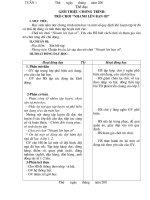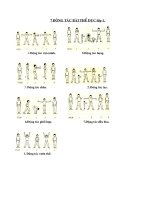- Trang chủ >>
- Mầm non - Tiểu học >>
- Lớp 5
5 3 4 roots of the blues
Bạn đang xem bản rút gọn của tài liệu. Xem và tải ngay bản đầy đủ của tài liệu tại đây (2.8 MB, 12 trang )
Suggested levels for Guided Reading, DRA,™
Lexile,® and Reading Recovery™ are provided
in the Pearson Scott Foresman Leveling Guide.
Roots Blues
of
the
by Peggy Bresnick Kendler
Genre
Narrative
nonfiction
Comprehension
Skills and Strategy
• Main Idea and
Details
• Author’s Purpose
• Graphic Organizers
Text Features
•
•
•
•
Captions
Sidebars
Map
Glossary
Scott Foresman Reading Street 5.3.4
ISBN 0-328-13541-0
ì<(sk$m)=bdfebh< +^-Ä-U-Ä-U
Vocabulary
appreciate
barber
choir
released
religious
slavery
Reader Response
1. What is the main of this book? List three details from
the book that support this idea.
Roots
Blues
2. Using a graphic organizer like the one below, write
down some of the things you have learned about calland-response, field hollers, and spirituals.
Call-and-response
Field hollers
Spirituals
of
the
by Peggy Bresnick Kendler
teenager
Word count: 1,293
3. An antonym is a word that has the opposite meaning
of another word. List at least one antonym each for
the words slavery and released.
4. How do you think modern rock music is similar or
related to the blues? Be sure to give one or more
examples.
Note: The total word count includes words in the running text and headings only.
Numerals and words in chapter titles, captions, labels, diagrams, charts, graphs,
sidebars, and extra features are not included.
Editorial Offices: Glenview, Illinois • Parsippany, New Jersey • New York, New York
Sales Offices: Needham, Massachusetts • Duluth, Georgia • Glenview, Illinois
Coppell, Texas • Ontario, California • Mesa, Arizona
West African Music
The blues is a style of music. It has been popular
in the United States since its invention in the early
1900s. Its roots go back to the music of West Africa.
Music has always been important to the many
cultures of West Africa. It is a part of life for even
the youngest West African child. For centuries, West
Africans have made music in many ways for all sorts
of occasions.
In West Africa, music or dance is a part of many
activities, such as working, playing, and celebrating.
Songs are often sung accompanied by drums, or with
stringed musical instruments similar to the guitar
and banjo.
Every effort has been made to secure permission and provide appropriate credit for
photographic material. The publisher deeply regrets any omission and pledges to
correct errors called to its attention in subsequent editions.
Blues has its roots in West African music.
Unless otherwise acknowledged, all photographs are the property of Scott Foresman,
a division of Pearson Education.
Photo locators denoted as follows: Top (T), Center (C), Bottom (B), Left (L), Right (R),
Background (Bkgd)
Opener: ArenaPal/Topham/The Image Works, Inc.; 1 Getty Images; 3 North Wind
Picture Archives; 4 Corbis; 5 North Wind Picture Archives; 6 The Historic New Orleans
Collection/Accession #1975.93.2; 8 (T) Getty Images, (B) New York Public Library Picture
Collection/Art Resource, NY; 10 (BR) Getty Images, (BL) Brown University Library; 11
Library of Congress; 12 (TR) Corbis, (BR) Rue des Archives/Lebrecht Collection; 13 Getty
Images; 16 (BR, BL) ArenaPal/Topham/The Image Works, Inc.; 17 (R) Getty Images, (TL)
Reuters/Corbis, (BL) Forum/Lebrecht Collection, (BL) David Redfern/Retna, Ltd.; 18 (T)
Getty Images, (BR) The Image Works, Inc.
ISBN: 0-328-13541-0
Copyright © Pearson Education, Inc.
All Rights Reserved. Printed in China. This publication is protected by Copyright,
and permission should be obtained from the publisher prior to any prohibited
reproduction, storage in a retrieval system, or transmission in any form by any
means, electronic, mechanical, photocopying, recording, or likewise. For information
regarding permission(s), write to: Permissions Department, Scott Foresman, 1900 East
Lake Avenue, Glenview, Illinois 60025.
4 5 6 7 8 9 10 V0H3 14 13 12 11 10 09 08 07 06
3
West African Musical Traditions
West African music is unique. It combines
sounds from nature with spoken words. Each
sound and song has its own unique meaning
to the African people.
People called griots played an important
role in West African music. Griots were musical
entertainers. They played instruments that
looked and sounded similar to a banjo.
The griots traveled from village to village
playing music, telling jokes and stories, and
giving advice. They knew about the history of
each village and explained it through songs
and stories. People came to appreciate them
for the advice and entertainment that they
offered.
A West African banjo (left)
and a North American
banjo (right)
4
The music that would become the blues developed among
enslaved African Americans.
Coming to America
The English colony of Virginia was started
in 1607. The first shipment of enslaved people
arrived in 1619. This date marks the true
beginning of the history of the blues.
The enslaved people were West Africans.
They had been captured from their villages
and forced onto ships bound for the Americas.
Once the West Africans arrived, plantation
owners purchased them from the people who
brought them over. The West Africans were
given just food, water, and shelter, but they
were not paid for their work. And they were
not free to leave. Living in slavery was very
hard.
5
Enslaved West Africans
developed “call-andresponse” singing.
A Life of Slavery
Between 1619 and 1808, millions of enslaved
West Africans were brought by ship to the Americas.
Among them were West Africans who had once
been griots. Instead of telling jokes and stories as
they would have back in West Africa, these former
griots sang songs that told of their unhappiness and
expressed their fear that they would never see their
homes again.
6
Most enslaved people did farm labor on
plantations. They often sang work songs while
working in the fields.
These songs often focused on their sadness. But
they also kept the enslaved West Africans’ spirits
up as they worked. Enslaved people managed to
preserve the unique West African musical style
through their work songs.
While laboring in the fields, they used a West
African musical technique called call-and-response.
The song leader would call out a sentence or phrase.
Then the other people would sing with an answering
sentence or phrase, as a choir in a church might do.
Call-and-response was a kind of musical
conversation. One person led, and the others
followed. The enslaved people also sang field hollers.
These were long, drawn-out cries sung over long
distances, from one field to the next.
7
Religion Shapes Music
A modern choir
Many of the enslaved West Africans were
introduced to Christianity after they were
brought to the Americas. They continued to
celebrate their own West African traditions, but
they also practiced some parts of Christianity.
The parts that spoke about freedom from
suffering were especially popular.
The plantation owners forbade their
enslaved workers from meeting in groups, so
they met secretly. During those secret meetings
they prayed, danced, and spoke of their own
personal experiences. They also sang a type of
song called a spiritual.
Spirituals were both religious and full of
emotion. They expressed the enslaved West
Africans’ feelings and hopes for the future.
Spirituals played an important role in the
development of blues music.
Early African Americans sang spirituals, songs that
reflected their hopes for the future.
8
9
The Blues Comes of Age
No one knows where the first blues song was
performed, or who sang or wrote it. What we do
know, however, is that blues music sprang up in
different parts of the American South during the
1890s.
Early blues music was inspired by call-andresponse, field hollers, and spirituals. The earliest
blues singers played handmade musical instruments,
which made interesting and unusual sounds.
Among these early instruments were the
handmade banjo, and the washboard and stick.
Later on, blues musicians would play guitars, pianos,
and harmonicas. Blues musicians became known for
experimenting with different sounds.
Early blues music was usually played by roaming
musicians who were similar to the griots. Their
audiences were mostly farm workers who would
take breaks from their work and dance to the music.
The Roots of Blues Music
1912 An early blues song,
W. C. Handy’s “Memphis
Blues” is published.
1914 W. C. Handy’s “St.
Louis Blues” is published.
10
1920 Mamie Smith
records “Crazy Blues.”
1923 Bessie Smith records
“Down Hearted Blues.”
Gertrude “Ma” Rainey
records “New Boweavil
Blues.” The recordings
help make blues popular
throughout the United
States.
1925–1929 “Blind
Lemon” Jefferson
records nearly one
hundred blues songs.
1930s Different types
of blues music begin
to appear in different
areas, such as the
Mississippi delta and
Memphis, Tennessee.
11
Early blues
musician W. C.
Handy is
sometimes
called “the
Father of the
Blues.”
Mamie Smith was a stage singer and the
first person to record a blues song. Smith
recorded “Crazy Blues” in 1920. Smith
inspired other female singers to record
blues music.
“Blind Lemon” Jefferson
was a singer, musician, and
songwriter. Jefferson, who
was blind since childhood,
recorded nearly one hundred
blues songs from 1925 to 1929.
Early Blues Musicians
In 1903, W. C. Handy heard a man in the
Tutwiler, Mississippi, train station playing the
guitar. The man slid a pocket knife up and
down the guitar, making an unusual sound.
What Handy heard was an early form of the
slide guitar blues. Later, he wrote down the
notes. Blues historians believe this was the first
time that blues music was written down.
Handy later gained fame as a bandleader,
songwriter, and performer. He published
“Memphis Blues,” an early blues song, in 1912.
12
Bessie Smith
was an early
blues singer.
She wrote many
blues songs,
including the
hit, “Back Water
Blues.” She also
influenced many
future female
blues singers.
Gertrude “Ma” Rainey
is sometimes called “the
Mother of the Blues.”
She began singing blues
on stage in 1904 and
recorded blues music in
1923.
13
Different Places, Different Styles
The Delta Blues began among African
Americans of the Mississippi Delta. It blended
work songs and field hollers with musicians
playing slide guitars and harmonicas. In
Chicago, blues musicians added electric guitar
and drums to the Delta Blues style. Their music
became known as Chicago Blues.
Slavery was abolished in 1865. Formerly
enslaved people were released to settle
anywhere in the country. Different styles of
blues were created as they moved around.
The Memphis Blues, which originated in
Memphis, Tennessee, featured one guitarist
playing rhythm guitar and another one
playing lead guitar. The East Texas Blues
sounded like old work songs. It used guitar or
piano for rhythm. The Piedmont Blues, from
North Carolina, was influenced by ragtime, a
form of jazz music. It was more melodic than
other blues styles.
Chicago Blues
•
Illinois
West
Virginia
Virginia
Memphis Blues
Different styles of blues
music developed across
the United States.
Piedmont Blues
•
North
Carolina
Delta Blues
South Carolina
Texas
Georgia
Tennessee
East Texas Blues
Louisiana
Mississippi
Arkansas
14
15
Modern Blues Greats
There have been hundreds of great blues
musicians since the early 1900s. Millions of listeners
have enjoyed their music.
The most famous blues musicians each have their
own style and talent. For example, Bo Diddley’s soul
music influenced rock and roll. Billie Holiday was
a world-famous female vocalist. Her soulful style
of singing the blues was unique and personalized.
John Lee Hooker’s growling voice blended with one
repeating musical chord for a special blues style.
B. B. King, who grew up in Mississippi and lived
in Memphis, Tennessee, as a teenager and young
man, has been called “the King of the Blues.” King
often picks at a single guitar string to produce many
different emotional sounds. As a boy, Muddy Waters
worked in the cotton fields of the Mississippi delta.
In the early 1940s, he moved to Chicago to play the
blues. Waters eventually became one of the great
Chicago Blues musicians.
John Lee Hooker
Billie Holiday
Bo Diddley
Muddy Waters
B. B. King
16
17
The Blues and Its Relatives
The blues is related to many forms of popular
music, including the jazz that is being played
by these musicians.
18
Blues music has had a major influence on
today’s popular music. You can find elements
of the blues in most of the modern popular
music styles, including jazz, rock, rap, and soul.
Buddy Bolden formed one of the first jazz
bands in 1895. Buddy, who may have started
out working as a barber, played the cornet, an
instrument similar to a bugle or trumpet. His
jazz music sounded a great deal like the blues
music of the time.
One of today’s popular musical styles,
rap, comes from the same roots as the blues.
Rap has rhyming lyrics. The lyrics are spoken
rhythmically while musical instruments are
played. Rap music often tells stories in a style
similar to that used by the griots.
Without the blues, American music would
be very different from what it is today. From
its quiet beginnings, the blues has become a
major part of American life!
19
Glossary
Vocabulary
appreciate
appreciate
v. to think
highly of; to recognize the
barber
worth
or quality of; value;
enjoy
choir
barber
n. a person whose
business is cutting hair
and
shaving or trimming
released
beards
choir
n. a group of singers
religious
who sing together, often
in slavery
a church service
released v. let go, freed,
unlatched
teenager
Reader Response
religious adj. much
interested in the belief,
study, and worship of
God or gods; devoted to
religion
slavery n. the condition
of being owned by
another person and being
made to work without
wages
1. What is the main of this book? List three details from
the book that support this idea.
2. Using a graphic organizer like the one below, write
down some of the things you have learned about calland-response, field hollers, and spirituals.
Call-and-response
Field hollers
Spirituals
teenager n. a person
between the ages of
thirteen and nineteen
Word count: 1,293
3. An antonym is a word that has the opposite meaning
of another word. List at least one antonym each for
the words slavery and released.
4. How do you think modern rock music is similar or
related to the blues? Be sure to give one or more
examples.
Note: The total word count includes words in the running text and headings only.
Numerals and words in chapter titles, captions, labels, diagrams, charts, graphs,
sidebars, and extra features are not included.
20









